TEXT OF INTERVIEW
SCOTT JAGOW: Companies and business groups around the country seem to have found a new cause: Early childhood development, kids who are four and five and might be at-risk for falling behind before they even get started. But why are corporations and chambers of commerce putting their money into this? Our Economics Correspondent Chris Farrell has some answers.
CHRIS FARRELL: You know most big businesses have a foundation, they do philanthropy. And the CEOs are increasingly frustrated because they’ve been putting a fair amount of money into education. So they put it in the high schools and that doesn’t see much of an effect so then they go back to the middle school maybe have more of an effect. And so they’re putting pressure on their people, saying ‘what’s the biggest bang for my buck?’ What their people are coming to them and saying is the biggest bang for the buck is to invest in early childhood education for at-risk kids between birth and age five.
JAGOW: Is that something that they think will really produce benefits for their company?
FARRELL: For their company? Probably not. This is a case of not wanting to waste your dollars. And a case of overall global competitiveness. But by the way this is fairly recent. I do think that we are reaching a tipping point in the business community. A couple years ago you would find somebody like George Kaiser the oil and banking billionaire in Oklahoma who had taken this up as a personal cause and Oklahoma now has more 4-year-olds in preschool than any other state. And what is now happening in state after state is that this is the issue that the business community seems to be coalescing around. And it is the research that is giving it the impetus. It is research such as by James Heckman, Nobel laureate at the University of Chicago, which shows that on average rate of return on investing in these types of intensive programs for at-risk kids is about 16 percent. Now that leaves the stock market way behind. Sixteen percent is a stunning rate of return.
JAGOW: How does that manifest itself?
FARRELL: Ahh, now this is what economists love. So you know they try to figure out, OK if we put a dollar into one of these programs what’s the return? And the return largely comes from two things: improved earnings next to a control group and probably the most famous study is called the Perry. It was 123 very low-income African American children and about half got an intensive program plus the family was visited at least once a week and then there was a control group that did not participate in this intensive program. And so it’s studies like this that are being looked at, examined. And the other is not getting arrested, not committing criminal acts, not going to jail. So part of the rate of return, when people say 16 percent rate of return, part of it is captured by the individual but the big part of it is actually captured by society.
JAGOW: Chris Farrell is the Marketplace Economics Correspondent. In Los Angeles, I’m Scott Jagow. Thanks for listening and enjoy your Monday.
There’s a lot happening in the world. Through it all, Marketplace is here for you.
You rely on Marketplace to break down the world’s events and tell you how it affects you in a fact-based, approachable way. We rely on your financial support to keep making that possible.
Your donation today powers the independent journalism that you rely on. For just $5/month, you can help sustain Marketplace so we can keep reporting on the things that matter to you.


















